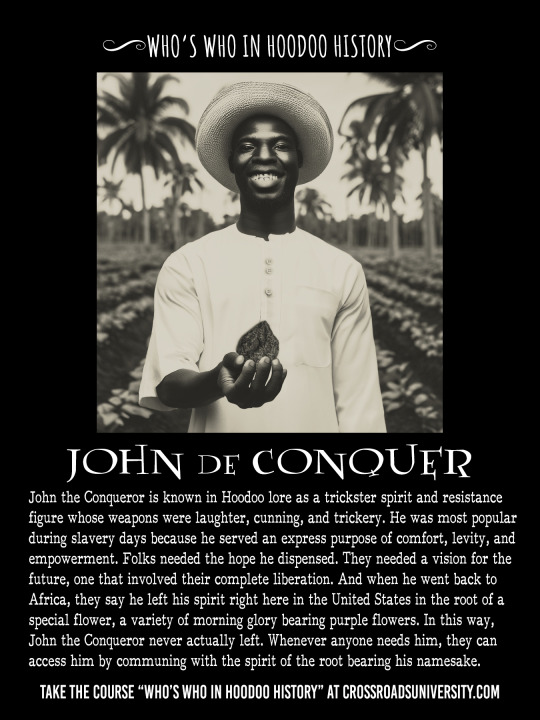#JohnnyConker
Explore tagged Tumblr posts
Text

Who's Who in Hoodoo History: High John the Conqueror
John the Conqueror is known in Hoodoo folklore as a trickster spirit, always making a way out of no way at all, “hitting a straight lick with a crooked stick. Winning the jackpot with no other stake than a laugh” (Hurston 1943, 452). Slaves saw him as emerging from a whisper, finding laughter in sorrow, irony in tragedy, and triumph in despair. He was the bringer of hope, “the source and soul of our laughter and song.” He provided much-needed comedic relief in everyday life. He was a resistance figure whose weapons were laughter, cunning, and trickery.
They say that John was a prince who came from Africa, walking on the winds that filled the sails of ships through the Middle Passage. There are no photographs or drawings of the actual John the Conqueror. However, some say he resembled big John Henry, the “steel-driving man” of African American folklore. Or maybe he was “a little, hammered down, low-built man like the Devil’s doll-baby” (Hurston 1943, 452). Some say you can’t draw a spirit, so quit trying. Others say no one ever talked about what he looked like because it wasn’t necessary. White people never knew of his existence, which was by design; they weren’t supposed to know about him. He was the slaves’ biggest advocate on the downlow, and they lived for the tales of his putting one over on ole Massa.
They say that the spirit of John the Conqueror was around in the form of Brer Rabbit before John came on the scene. That wily mammal had already made the rounds on the plantations for a year and a day by the time John came along. Because he was in the form of an entertaining bunny, his tales spread far and wide. In reality, Brer Rabbit and John the Conqueror are two different spirits, but their functions are similar. Both are tricksters; both gain the edge through cunning, audacity, and intelligence. Both are empowering resistance figures.
John the Conqueror’s renown comes from the abundance of folktales describing his exploits. The most significant tales involve his role in procuring freedom through comedic relief and trickery. Freedom was of primary concern to John, and it governed near about all of his decisions. But he wasn’t the same kind of resistance figure as San Malo, Bras Coupe, or Annie Christmas. He was good at playing dumb when he needed to, and he excelled at the art of gaslighting. He played ole Massa like a fiddle.
He could make you think yellow was green and green was yellow. He would make you believe that what he did was your doing, and he was a master at leaving ole Massa standing in his place, mouth agape. He was just that cunning.
John the Conqueror was most popular during slavery days because he served an express purpose. People needed the kind of resilience and inspiration he could bring. They needed the hope he dispensed. They needed a vision for the future, one that involved their complete liberation. And when he went back to Africa, they say he left his spirit right here in the United States in the root of a special flower, a variety of morning glory bearing purple flowers. In this way, John the Conqueror never actually left. Whenever anyone needs him, they can access him by communing with the root bearing his namesake.
*Excerpt from Witch Queens Voodoo Spirits and Hoodoo Saints: A Guide to Magickal New Orleans.
Learn more about the OGs of Hoodoo: https://www.crossroadsuniversity.com/courses/who-s-who-in-hoodoo-history
#hoodoo#conjure#rootwork#neworleansvoodoo#crossroadsuniversity#creolemoon#HighJohntheConqueror#JohnnyConker
291 notes
·
View notes